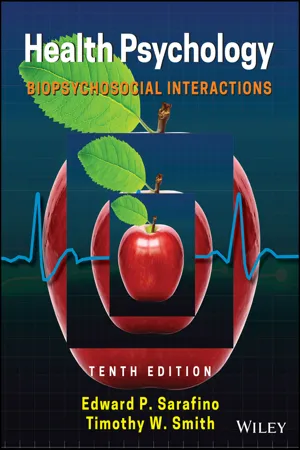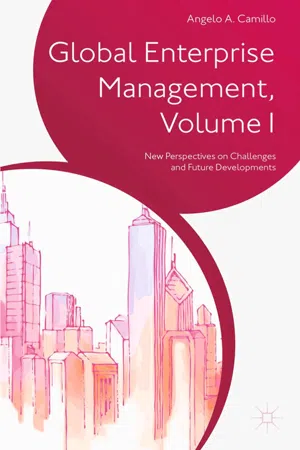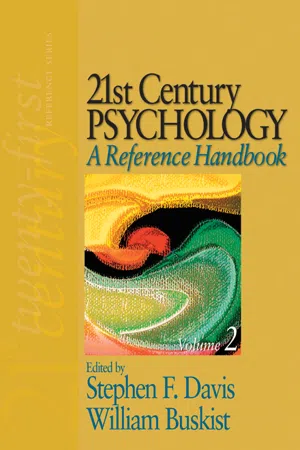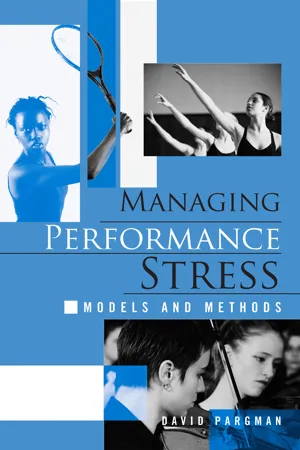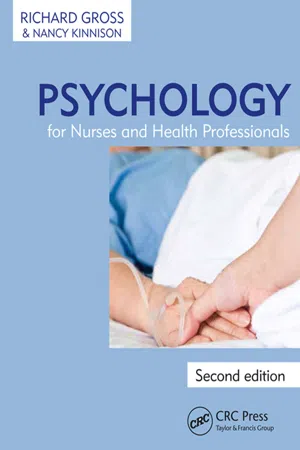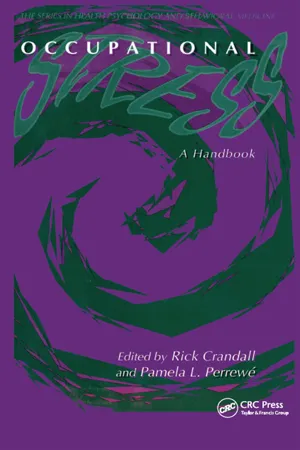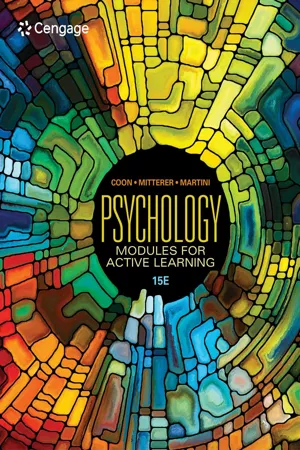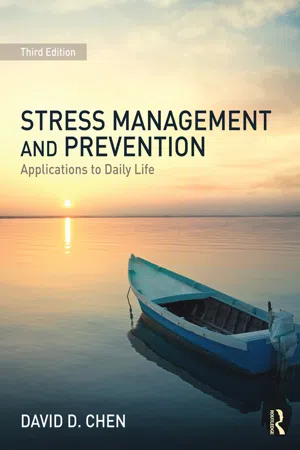Psychology
Sources of Stress
Sources of stress can be categorized into external and internal factors. External sources include major life events, daily hassles, and environmental stressors, while internal sources stem from one's thoughts, beliefs, and attitudes. These stressors can lead to physical, emotional, and behavioral responses, impacting an individual's overall well-being.
Written by Perlego with AI-assistance
Related key terms
1 of 5
12 Key excerpts on "Sources of Stress"
- eBook - PDF
Health Psychology
Biopsychosocial Interactions
- Edward P. Sarafino, Timothy W. Smith(Authors)
- 2021(Publication Date)
- Wiley(Publisher)
Stress is linked to psychosocial processes. It can impair cognitive functioning, reduce people’s helping behavior, and increase their aggressiveness. Various emotions can accompany stress—these emotions include fear, anxiety, de- pression, and anger. Although the sources of stress may change as people develop, the condition of stress can occur at any time in the life span. Sometimes stress arises from within the person, such as when the person is ill or experi- ences conflict. Another source of stress is the family, such as in marital conflicts and serious illnesses or death in the family. Although women are more likely than men to be caretakers of elderly relatives, a meta-analysis found that the amount of care men and women give is similar. A new baby with a difficult temperament can be stressful for par- ents, and stress during pregnancy can lead to premature births. Other Sources of Stress include the community and society—for example, problems related to people’s jobs, environmental conditions, the qualities of their neighbor- hoods, and the experience of discrimination. Researchers measure stress in several ways. One way assesses physiological arousal, such as changes in blood pressure and heart rate, with various sensors attached to the body. Biochemical analyses of blood or urine samples can test for corticosteroids (for example, cortisol) and cate- cholamines (for example, epinephrine and norepinephrine). Other methods to measure stress use surveys of people’s experience of life events, daily hassles, and experience of different chronic stressors. Although stress can contribute to the development of illness, many psychologists believe that not all stress is harmful. CREDITS 3-1 Frankenhaeuser, M. (1986). A psychobiological frame- work for research on human stress and coping. In M. H. Appley & R. Trumbull (Eds.), Dynamics of stress: Physiological, psychological, and social perspectives (pp. 101– 116). - eBook - ePub
Global Enterprise Management, Volume I
New Perspectives on Challenges and Future Developments
- A. Camillo(Author)
- 2015(Publication Date)
- Palgrave Macmillan(Publisher)
We make a contribution to the body of literature examining the links between organizational culture, job stress, and work conflict. Our contribution to this debate offers empirical findings about the correlations between these three aspects. The approach introduces a new framework applicable both as a tool for enhancing the understanding of job stress in the workplace, and as a useful guide to future research on job stress as a whole. The content discussed herein attempts to establish the building blocks for the scholarly development, and directions for future research studies are suggested.Physical and Psychosocial SourcesStudies conducted on workplace stress demonstrate that the Sources of Stress are many and varied (Armstrong & Griffin, 2004; Dowden & Tellier, 2004). Across countries, different methods and approaches have been used to investigate these issues (Sonnentag & Frese, 2003).Work stress can be broadly divided into physical (Van Yperen & Hagedoorn, 2003) and psychosocial sources (Chiang et al., 2010; Kim et al., 2009). Physical sources concern the work setting, that is, how the workplace is structured and organized in terms of health and safety hazards, or the contractual conditions of work that can have an impact on job stress. Psychosocial sources are related to personality traits, which are defined in this study as worker attitudes: an internal (or external) locus of control, and other typical personality traits such as conflict, social relationships on the job, the relationship between home and work, and other stressful factors (Chiang et al., 2010; Kim et al., 2009).Physical Sources: Organizational Position and Organizational SizeIn general, there is consensus in the literature on stress that reports job stress as a function of the work situation and the psychological characteristics of each individual (Fernet et al., 2004; Kim et al., 2007; Schaubroeck et al., 2000). However, as Jaffe (1996) contended, prior studies place too much emphasis on psychological sources rather than on work environments and the ways in which they can produce or alleviate stress. As Kompier et al. (2000) cautioned, the consideration of psychological sources alone is reactive and lacks the ability to produce sustained long-term benefits. Sparks and Cooper (1997) echoed this concern, as did Cartwright and Cooper (2002), who proposed that the most effective way in which organizations can reduce job stress is by eliminating or modifying the Sources of Stress inherent in the work environment. Some studies on the role of physical stressors (Boyd et al., 2009; Caplan et al., 1975; Kim et al., 2007; Kim et al., 2009; Penney & Spector, 2005) have revealed organizational position and organizational size as the top key factors. - Stephen F. Davis, William Buskist, Stephen F. Davis, William F. Buskist(Authors)
- 2007(Publication Date)
- SAGE Publications, Inc(Publisher)
175 70 S TRESS AND S TRESSORS J EFFREY R. S TOWELL Eastern Illinois University S tress is what we experience through a complex interplay between external forces in the environment (stressors) and our perceived ability to adapt to them. Although often viewed as harmful, stress is a normal adap-tive response that helps us deal with life’s difficulties and prepare for action. Not all stress is bad, and in many cases it is necessary to perform optimally. This chapter provides a general overview of how stress is defined, its effects on psy-chological and biological processes, ways to measure dif-ferent types of stress, and how stress is affected by cultural experiences. This chapter is closely related to other chapters on coping (how people deal with stress) and health psychol-ogy because stress is one of many psychological factors that can influence the incidence or progression of disease. Stress can arise from external or internal sources, con-flict, harm, loss, challenge, or frustration. Prolonged or chronic stress can have detrimental effects on a person’s psychological and mental health, but important individual differences exist that may make a person more vulnerable or sensitive to external Sources of Stress. Psychological and physiological changes that accompany stress are measur-able and are related to various outcomes. Because of the significant impact stress can have on our lives, researchers are interested in finding ways to manage stress effectively and glean the benefits it provides while minimizing its harmful effects. INTRODUCTION According to Richard Lazarus (1999), early models of psy-chological stress adopted analogies from engineering and physics. Robert Hooke, a 17th-century physicist-biologist, discussed how external force (load) applied to a particular area of a structure (stress) creates deformation (strain) of that structure.- eBook - PDF
I Never Knew I Had a Choice
Explorations in Personal Growth
- Gerald Corey, Marianne Corey, Michelle Muratori, , Gerald Corey, Marianne Corey, Michelle Muratori(Authors)
- 2017(Publication Date)
- Cengage Learning EMEA(Publisher)
Those who encounter xenophobia and become targets of discrimination and hate upon arriving in the United States are likely to be further traumatized. Many of the stressors of daily life come from external sources. D-N-D/Shutterstock.com Copyright 2018 Cengage Learning. All Rights Reserved. May not be copied, scanned, or duplicated, in whole or in part. WCN 02-300 The national economic crisis, which has resulted in a dramatic increase in unemploy-ment, home foreclosures, and bankruptcies, has shattered the American dream for many families. Disillusioned and in debt, people are under enormous stress and are worried about the future. Listening to daily news reports of the ravages of war and violence, and watching public figures act in their own self-interest rather than in the interests of their constituents, affects us psychologically and physically. The tragic events of 9/11 activated a level of fear new for most Americans as we realized how vulnerable we are. We are confronted daily with the reality that we can no longer assume that we are safe, which we once took for granted. This uncertainty is a source of stress that has profoundly affected the psyche of Americans and has had a global impact. Any set of circumstances that we perceive as being threatening to our well-being puts a strain on our coping abilities. Stress is in the mind of the beholder, and our appraisals of stressful events are highly subjective. How we label, interpret, think about, and react to events in our lives has a lot to do with determining whether those events are stressful. Weiten, Dunn, and Hammer (2018) describe frustration, internal conflict, change, and pressure as four key ele-ments of psychological stress. As we consider each of these Sources of Stress, think about how they apply to you and your life. Frustration results from something blocking attainment of your needs and goals. - eBook - PDF
Health Psychology
Biopsychosocial Interactions
- Edward P. Sarafino, Timothy W. Smith, David B. King, Anita De Longis(Authors)
- 2020(Publication Date)
- Wiley(Publisher)
Stress originating in the workplace can also “spill over” and affect a number of outcomes at home. (Go to .) 98 Chapter 3 Stress—Its Meaning Impact, and Sources Environmental Stress People’s environments can be significant Sources of Stress. Some environmental stressors are of only moderate levels, such as when we are at an event in a noisy, crowded arena (Evans, 2001). Crowding reduces our control over social interaction and restricts our ability to move about freely. Other environmental condi- tions create much more intense and chronic stressors, such as when a constant threat of violence or serious harm exists—as occurs in many parts of the world today. Even in areas as yet spared from war or terrorism in nearby communities, people feel threat- ened, and the resulting stress can influence their physical health (Levy & Sidel, 2009; Llabre & Hadi, 2009; Shalev et al., 2006). In this way, we can think of some environ- ments as being healthier than others, with stress being an important factor to consider (Taylor, Repetti, & Seeman, 1997). Imagine how you would react to learning that a hazardous substance has seeped into the water supply where you live. How much of it have you and your family already consumed? Will you develop serious illnesses because of it in the future? Can the sub- stance be removed? And after it is, will you believe there is no more danger? Many people who are exposed to hazardous substances or other continuous threats in their environment worry for years about what will happen to them (Baum, 1988; Bland et al., 1996; Specter, 1996). Natural disasters, such as earthquakes, also create long-term disruptions in social relationships, which worsen the stress (Bland et al., 1996). In 1992, 26 men were killed in the Westray Mine explosion in Plymouth, Nova Sco- tia. - eBook - PDF
- Jan Felicjan Terelak(Author)
- 2019(Publication Date)
- Peter Lang Group(Publisher)
2 Identification of stressors Psychological stressors can be of various nature. The most commonly talked about are ecological threats to man and the Earth, shared by contemporary people, supporters of post modernity and global capitalism. It is difficult to ac- cept any common classification of Sources of Stress, as they significantly exceed the list of environmental risks and, moreover, there are no applicable distribu- tion criteria. The criterion adopted should cover both the type of stress stimulus, its strength (intensity), as well as the duration or frequency of its occurrence. In the latter case, we are dealing with a distinction between incidental and chronic stress, which is important because their effects can vary. The criterion of the strength of a stress stimulus is also not very convenient despite its quantitative characteristics, as it is not only the physical component of the force itself that is important, but the psychological significance of the stimulus, which significantly modifies the response to stress. When contemplating the organism as a multidimensional unit, attention is drawn to the fact that environmental and personal factors are transactional because, by influencing each other, they cause stress responses to reflect the new systemic quality of the organism. This infinite number of transactions has prompted some psychologists to seek a correlation between a single environ- mental factor and an individual reaction of the organism, and others to take the approach that the environment is such a compact entity that it should not be dissected into individual factors at all. The first of these approaches led to many controversial results, while the second one led to completely unscientific discussions. In psychology of stress, similar extreme views can be found, but the situation is even more complicated if one takes into account the social character- istics of the environment and one’s own deliberate activity. - eBook - PDF
- A. Weinberg, C. Cooper(Authors)
- 2011(Publication Date)
- Palgrave Macmillan(Publisher)
62 CHAPTER 4 What do t he sour ces of pressure mean to us ? This chapter examines three aspects of l ife affected by tur- bulent ti mes and the psychological challenges which can fol- low from each aspect: namely , work, home life and f inance. During the usual course of things, we can expect to face dif- f iculties in each of these areas, but a common consequence of widespread economic, political or environmental change is that problems can arise si multaneously in more than one domain. This creates an increased likelihood that we will struggle with multiple demands across key aspects of our lives ( see Figure 4.1 ) . This is a bit like the physical phenomenon of Figure 4.1 A resonance model of organizational stress in turbulent times Source: From Weinberg, A., and C.L. Cooper (2011), ‘The challenge of stress in mod- ern organizations’; in R.J. Contrada and A. Baum (eds.) Handbook of Stress Science: Biology, Psychology, and Health, 151–66. New York: Springer (2010). Individual factors: • Mood • Health • Work • Non-work Organizational factors: • Expectations • Change • Culture • Technology • Workforce Global factors: • Political • Economic • Population • Climate TIME 63 What do the sources of pressure mean to us ? the i mpact of sound waves on a glass when they synchroni ze, so that greater and greater vibrations can eventually cause it to shatter. Hopefully , as humans we do not reach ‘break - ing point’, but it can help to recognize where sources of pres- sure are coming from so that we can anticipate the potential impact and seek the best survival strategies before disaster strikes, even where there are no ideal solutions. By taking work, home life and finance in turn, this chapter will look at potential sources of pressure and the ways in which these can undermine our sense of well-being. The following chapters look at potential strategies for dealing with these challenges. - eBook - ePub
Managing Performance Stress
Models and Methods
- David Pargman(Author)
- 2013(Publication Date)
- Routledge(Publisher)
3
Sources of Stress
LEARNING OBJECTIVES
After reading this chapter, you should be able to:- Interrelate the terms stress and stressor
- Describe Freud’s definition of anxiety and discuss his views of anxiety causation from a psychoanalytic perspective
- Define displacement, repression, denial, and rationalization
- Identify the primary distinction between psychoanalytic and learning perspectives of stress
- Define modeling and discuss it in relationship to stress from a social learning perspective
- Elaborate upon value dissonance and social change as they relate to stress from a sociological/environmental perspective
- Discuss how personality may interact with stress
- Contrast trait and state anxiety
- Distinguish among social, physical, chemical, bacterial, and climatic stressors
IMPORTANT TERMS
- Defense mechanisms
- Value dissonance
- Personality
- Personality trait
3.1 INTRODUCTION
Now that we have a sense of what stress is, let us turn to the matter of its origins. Where does it come from? Being able to understand this phenomenon and differentiate it from other similar human, psy-chophysical responses is but one concern. In order to strengthen our understanding of stress, it is important to appreciate its causal factors, that is, the underlying experiences that result in stress response.As noted previously, the perspective adopted in this book is that stress is a reactive experience and that s tressors are external or inter-nal environmental stimuli that provoke it. However, experts differ with regard to the importance allocated to these stimuli or Sources of Stress.3.2 DIFFERENT THEORETICAL APPROACHES
In accordance with their training and background, many theorists approach the challenging question of stress causality from strikingly different directions. Some authorities consider only social factors as being causally related to human stress reactions. Others indict deeply rooted unconscious factors, while learning and reinforcement are par-amount in the explanations of other theorists. - Richard Gross, Nancy Kinnison(Authors)
- 2017(Publication Date)
- Routledge(Publisher)
75 Stress: Definitions and causes 4 Introduction and overview According to Bartlett (1998), … the notion that stress is bad for you and can make you ill has become a modern cultural truism. However, there is also a significant body of research evidence which lends support to this idea … The study of stress must … be central to … health psychology, which con-cerns, at its most basic level, the role of psychosocial processes in health and disease. Definitions of stress fall into three categories (Bartlett, 1998; Goetsch and Fuller, 1995): 1. Stress as a stimulus 2. Stress as a response 3. Stress as an interaction between an organism and its environment. In turn, this classification corresponds very closely to the three models of stress identified by Cox (1978): 1. The engineering model , which is mainly concerned with the question ‘what causes stress?’ 2. The physiological model , which is concerned with ‘what are the effects of stress?’ 3. The transactional model , which is concerned with both the aforementioned questions plus ‘how do we cope with stress?’ Although stressors are faced by everyone (especially, perhaps, those living in constantly changing Western cultures), some face greater demands than others. As a group, patients (both in and out of hospital) face Sources of Stress that they did not have to deal with before becoming ill. Similarly, while all 76 Stress: Definitions and causes occupations are stressful, some are more stressful than others. Several studies have suggested that health workers experience more stress than comparable groups of non-health workers (Jones, 1995). In terms of Warr’s (1987) vita-min model, which identifies several environmental factors that affect mental health, nurses and other health professionals are likely to suffer from organ-isational stressors that are common to many other occupations (such as lack of clarity, conflicting roles, work overload and lack of control).- eBook - ePub
Occupational Stress
A Handbook
- Rick Crandall(Author)
- 2020(Publication Date)
- CRC Press(Publisher)
Although several models of work stress have represented the putative influence of nonwork stressors on distress (e.g., Bhagat, 1983; Matteson & Ivancevich, 1987), the most detailed model in this regard has been proposed by Greenhaus and Parasuraman (1986). These authors posit that three categories of stressors can be distinguished: (1) stressors stemming from one’s job (e.g., work overload, role ambiguity), (2) stressors related to conditions within nonwork domains of life such as the family (e.g., marital inequity, emotional distance, child problems), and (3) stressors involving the interface of work and nonwork domains (e.g., work-family conflict). According to this model, all three types of stressors may make a unique contribution to an individual’s well-being.In keeping with Greenhaus and Parasuraman’s (1986) contention, research has recently begun to examine the unique predictive powers of job stressors, family stressors, and work-family conflict with regard to psychological distress (e.g., Barnett & Marshall, 1992; Bedeian, Burke, & Moffett, 1988; Bromet, Dew, & Parkinson, 1990; Burke, 1988; Frone, Russell, & Cooper, 1992; Higgins, Duxbury, & Irving, 1992; Klitzman, House, Israel, & Mero, 1990; Kopelman, Greenhaus, & Connolly, 1983; Parasuraman, Greenhaus, & Granrose, 1992; Phelan et al., 1991). Although results are mixed, this growing body of research suggests that each stressor has important implications for psychological well-being. Nonetheless, prior research suffers from two major limitations. First, few studies have controlled adequately for the potential confounding influence of sociodemographic characteristics and indicators of psychosocial resources or vulnerabilities. For example, having young children in the house or having limited access to supportive relationships (social support) may be associated with higher levels of both work-family conflict and psychological distress. Second, most studies have typically employed convenience samples drawn from a single organization or occupation. Thus, until stronger controls and more heterogeneous and representative samples are utilized, the results of prior studies are vulnerable to third variable explanations and their generalizability may be limited. These limitations suggest that additional research taking into account a broad range of potential confounding variables and using more broadly representative samples would be useful. - eBook - PDF
Psychology
Modules for Active Learning
- Dennis Coon, John Mitterer, Tanya Martini, , Dennis Coon, John Mitterer, Tanya Martini, (Authors)
- 2021(Publication Date)
- Cengage Learning EMEA(Publisher)
In one study, nurses with a high sense of Stressor Specific condition or event that challenges or threatens a person. Primary appraisal Deciding if a situation is relevant to oneself and if it is a threat. Secondary appraisal Deciding how to cope with a threat or challenge. ➤ Figure 56.1 The origins of stress. Stress is the product of an interchange between a person and the environment. Primary Appraisal relevant? threatening? Secondary Appraisal coping resources available? course of action? Notice of Workforce Reduction Stressor intense? repeated? unpredictable? uncontrollable ? pressure? Copyright 2022 Cengage Learning. All Rights Reserved. May not be copied, scanned, or duplicated, in whole or in part. Due to electronic rights, some third party content may be suppressed from the eBook and/or eChapter(s). Editorial review has deemed that any suppressed content does not materially affect the overall learning experience. Cengage Learning reserves the right to remove additional content at any time if subsequent rights restrictions require it. PSYCHOLOGY MODULES FOR ACTIVE LEARNING 486 control (e.g., over the pacing of work and the physical ar-rangement of the working environment) were less likely to get sick, either physically or mentally, than nurses with a low sense of control (Ganster, Fox, & Dwyer, 2001). To summarize, when emotional “shocks” are uncontrol-lable, unpredictable, and linked to pressure, stress is mag-nified and damage is likely to result. At work, people face many of these Sources of Stress every day (Bliese, Edwards, & Sonnentag, 2017). (See ■ Table 56.1 for a list of the most common Sources of Stress at work.) In fact, chronic job stress sometimes results in burnout. Burnout When workers are physically, mentally, and emotionally drained, they may experience burnout (Leiter, Gascón, & Martínez-Jarreta, 2010). - eBook - ePub
Stress Management and Prevention
Applications to Daily Life
- David D. Chen(Author)
- 2016(Publication Date)
- Routledge(Publisher)
Sources of Stress across the Lifespan
David D. Chen DOI: 10.4324/9781315695594-3So far I have been talking about stress in the most general terms. I have discussed the ways the body responds to stress, described how neurological and endocrine systems function, and outlined the mechanisms of the fight-or-flight reflex. Each of these descriptions refers to how people (or organs) behave, without reference to particular differences in the individual. Yet you know that not everyone acts the same way in given circumstances, nor do their bodies react identically.What determines the differences in individual responses to stress? One reason is variations in the ways each of us is built; not all mechanisms in the body are constructed exactly the same way. The heart and accompanying coronary connections are located in the chest, usually a bit off center to the left; but in truth, there are exceptions to this rule where particular organs end up a few inches in one direction or the other. Personality is another variable that influences stress responses, as are your background, gender, ethnicity, religion, and culture.Key Questions in the Chapter- How is human development reflected in a series of sequential stages?
- What are the “developmental tasks” of childhood? Adolescence? Young and middle adulthood? Later maturity?
- What is the theory of fetal origins of adult disease?
- How do primary and secondary appraisals of stress affect a person’s emotional responses?
- What are the major Sources of Stress throughout the lifespan?
- What are the most reliable indicators of serious suicidal intent among those who are overstressed?
- How are drugs and alcohol used as forms of self-medication?
- How does stress impair sexual functioning?
- What is the “family life cycle” and how does it influence the individual’s stress reactions?
The next several chapters look at some of the differences in the ways that people react to stress. I begin with one of the most obvious factors: the person’s age. Throughout the lifespan, from birth until old age, stressors take a different form, just as the capacity to respond to these stimuli changes as you mature. What concerns you most at this point in your life is quite different than what got under your skin a few years ago, or when you were in elementary school, or an infant.
Index pages curate the most relevant extracts from our library of academic textbooks. They’ve been created using an in-house natural language model (NLM), each adding context and meaning to key research topics.
